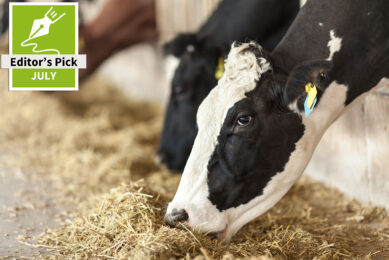Plant bioactives for healthy ruminants

Plants have been used throughout history for their medicinal properties. Current scientific evidence suggests plants also have potential to enhance animal health in general and that of ruminants in particular.
Simone Rochfort, Anthony Parker and Frank Dunshea review the current data.
In western culture, plants in the livestock industry have largely been considered as a source of nutrition or potential source of toxicity. Increasingly there is the realisation that plants may offer non-nutrient performance enhancing factors that benefit animal production (Greathead, 2003). However, plant bioactives are still an under explored area of research and relatively little work has been done for ruminant health. There is very little literature that focuses on plants as alternatives to antibiotics. In ruminant health the focus has been on bioactive effect of plants on ruminal flora rather than on specific pathogenic bacteria. This is perhaps understandable, since many of the desirable effects of antibiotics used as growth stimulants act through modification of the ruminal microbe population.
Effects on rumen environment
Active areas of research for plant bioactives (particularly saponin and tannin containing plants) include reproductive efficiency, milk and meat quality improvement, foam production/bloat control and methane production. Certain plants also seem to have positive effects on rumen and gut health. Recently, it was demonstrated that the forage species Dorycnium rectum contained a range of proanthocyanidins that had varying effects on ruminal bacteria. The plant is unusual compared to other temperate forage legumes since it contains condensed tannins (CT) of a very high degree of polymerisation. Tannins have traditionally been considered antinutritional but it is now known that their beneficial or antinutritional properties depend upon their chemical structure and dosage and they have shown potential antiviral, antibacterial and antiparasitic effects. Tannins are not the only metabolites that effect ruminant flora. Essential oils have demonstrated antibiotic activity in vivo and in vitro (Elgayyar et al., 2001; Moreira et al., 2005; Wallace et al., 2002). The oils of anise, oregano and cloves have been studied in poultry as an alternative to antibiotics and demonstrate that supplementation with oils may be a natural alternative to promote growth in chickens (Ertas et al., 2005). The use of such natural essential oils is under-explored in ruminants. In addition, this area of research is further limited by a concentration on in vitro studies with few in vivo studies done with grazing animals.
Bloat control
Pasture bloat is a costly disorder, particularly for cattle grazing on high protein improved pastures (Tanner et al., 1995). Frothy bloat is caused by the capture of ruminal gases in a polysaccharide slime layer and causes an inability of the animal to release gas pressure which is formed as a result of ruminal fermentation (Tanner et al., 1995). Proanthocyanidins have been demonstrated to reduce foam production in vitro in a dose dependant manner (Tanner et al., 1995). Similarly, Waghorn and Jones (1989) demonstrated an absence of bloat in cows fed dock (Rumex obtusifolius) at 10% of dry matter while consuming a lucerne based diet. In addition bloat scores in steers have been reduced by feeding Sainfoin herbage (Onobrychris viciifolia) at 10–20% dry matter (McMahon et al., 1999). Although it is possible to co-cultivate a bloat susceptible sward such as lucerne or clover with a CT containing plant such as Sainfoin, Lotus or Dock, consistent intakes of both plants by ruminants must be verified and production traits assessed before full recommendation to producers. This is an area, where additional
research could have significant industry benefits.
Mixed grazing systems or segregated feeding paddocks could reduce the incidence of bloat. For animals such as dairy cattle plant supplements could be added to their diet during milking. Research into additional plants that could be of use in situ and in lots would be a priority. In addition, it is still unclear if tannin is entirely and exclusively responsible for this benefit. Any research in this area would require extensive chemical analysis to ensure that tannin levels and types are qualitatively and quantitatively described across feeding studies.
Methane production
Methane is produced as a by-product of the digestive process and represents a loss of feed energy (2–12%) from the diet (Pen et al., 2006). Methane is also one of the primary greenhouse gasses and livestock production is the major source of anthropogenic methane (Wood and Knipmeyer, 1998). Both tannins and saponins have received attention for their ability to reduce methane production. Legumes containing condensed tannins decrease gas formation and microbial deamination due to plant–protein interactions. Reducing methane emissions and ruminal protein degradation could result in decreased metabolic energy losses and gaseous nitrogen emissions.
Tannins in many plants may reduce ruminal protein breakdown and increase duodenal protein flow when provided at moderate doses (Carulla et al., 2005). However, when given to animals at higher doses they may also adversely affect animal performance. Carulla et al. (2005) supplemented Acacia mearnsii tannins at a level of approximately 0.025% of the diet DM and significantly reduced methane emissions by 13%. However, the replacement of grass by legumes demonstrated no advantage in reducing methanogenisis. The research in this area raises the interesting possibility of supplemental feeding with feed that incorporates tannin-nutrient complexes as a mechanism to provide high value feed whilst lowering methane production.
Saponins are an important class of plant metabolites that show enormous structural diversity. Essentially they are terpene glycosides the composition of which can vary both in the core terpenoid (sterol derivatives to triterpenes) and also the number, type and substitution pattern of the glycoside residues. They have numerous biological effects and some can demonstrate highly selective and potent biological activities. Hess et al. (2003) found that the fruits of S. saponaria reduced methane production in an in vitro culture by 11% in grass-alone and legume supplemented diets. In vitro fermentation experiments using the ruminal fluid of Holstein cows (Pen et al., 2006) demonstrated that Yucca schidigera extract (YSE) decreased methane production whereas Quillaja saponaria extract (QSE) did not. Protozoal numbers decreased in both cases (56% with YSE, 41% with QSE). The authors suggest that the chemical nature of the saponins may be responsible for the differing activities.
Other methane studies
Other studies have demonstrated the reduction of methane by plant extracts, without identification of the active agents. Broudiscou et al. (2000) investigated the effect of 13 plant extracts in continuous culture. They observed little effect on protozoa numbers but showed that L. officinalis (lavender) and S. virgaurea promoted the extent of fermentation and that E. arvense and S. officinalis (sage) had a possible inhibitory effect on methane production. Though the plants were selected for their high flavonoid content, it cannot be assumed the flavonols
were responsible for activity. Patra et al. (2006) recently studied the in vitro effect of five plants (Acacia concinna, Terminlaia chebula, Terminalia beleerica, Emblica officinalis and Azadirachta indica) extracted with solvents of varying polarity (water, methanol and ethanol). Their results showed T. chebula could be used to reduce methane production. It was interesting to note that these researchers also observed that a decrease in protozoa counts (A. concinna, A. indica and T. chebula) does not necessarily mean a decrease in methane production.
A similar study (Sliwinski et al., 2002a) comparing Yucca schidigera extract to Castanea sativa wood extract (CSE; containing hydrolysable tannins and lignan) in in vitro rumen models showed effects on methane production only at very high levels. In vivo studies with fistulated lambs from the same authors concluded that there was a weak potential of YSE and CSE to favourably modify nitrogen turnover in the rumen, in the metabolism of the animal and in manure during storage. Sliwinski et al. (2002b) further concluded that the effects on methanogenesis were inconsistent between in vitro and in vivo data. The authors were using commercial products and suggest the cause for variation between these results and others is the variability in chemical constituents in each extract. This draws attention to studies using plants where levels of bioactives are unknown (Patra et al., 2006) and where these levels are likely to fluctuate with season and location. It also highlights the need for thorough chemical analysis to enable meaningful comparisons across all reported in vitro or in vivo studies.
Current research programmes
An increasing number of studies are dedicated towards the effects of plant extracts on methane reduction and animal health. Currently a large EU programme: Rumenup has been finalised. This work involved the collection of plants and screening them for various activities. Overall, the Rumen-up project was a success. Five hundred collected samples provided a wealth of data, with at least 25 being considered to have potential value as a feed additive to control the target detrimental activities of ruminal fermentation (Table 1). The data on the rest of the samples, when released into the public domain, will be a useful reference for many producers of plant materials, research nutritionists, agronomists and so on.
The fact that none of the targeted samples has reached commercial application as yet is more a function of the short-term nature and limited budget of the consortium than a scientific failure. There are also numerous other research programmes and research organisations that investigate the potential benefits of plant bioactives for ruminants. For example the Institute of Grassland and Environmental Research (IGER) in the UK carries out research aiming to optimise ruminant health. The focus of the research is generally forage based but they also utilise novel technologies, such as metabolomics, to investigate systems. Similar to IGER, AgResearch in New Zealand is a diverse organisation but several projects within it are of relevance and are focused on strategies to improve ruminant health. This includes the use of plants as replacements for antibiotics. In Australia, ruminant nutrition and the potential to utilise plants for animal health benefits are areas of on-going study both in the state-based Departments of Primary Industries (eg. Investigations into the effect of tannin on dairy cow heath and milk production) and the national research organisation, Commonwealth Science and Industry Research Organisation (CSIRO).
Conclusion
The use of plant bioactives for animal health is an area of increasing research importance. Many of the studies in ruminants to date have targeted specific classes of bioactives such as tannins and saponins. The focus of most ruminant research has been on ruminal flora modification for a reduction in methane emission and enhanced growth. The manipulation of meat and milk quality, particularly with respect to fatty acid composition, is an active area of research.
Feeding or supplementation with different plant materials appears to offer a means to alter the lipid composition in animal products, which may result in human health benefit. There have been several ruminant focused studies investigating the use of plants for nematocides, though the focus has again been on the effects of polyphenolics. However, there are plant bioactives of almost every chemical class that have demonstrated nematocidal or antibacterial activity suggesting that this could be a fertile area for future research.
One of the problems in assessing much of the available literature is a lack of chemical analysis for the feeds, despite evidence of structure activity relationships in both tannins and saponins. Additionally, many studies have relied on in vitro analysis via ruminal fermentors. This review suggests that plants may indeed be beneficial for animal health, whilst at the same time, highlights the need for more controlled in vivo research to validate plant bioactivity.
Source: Feed Mix magazine. Volume 16. No. 6











